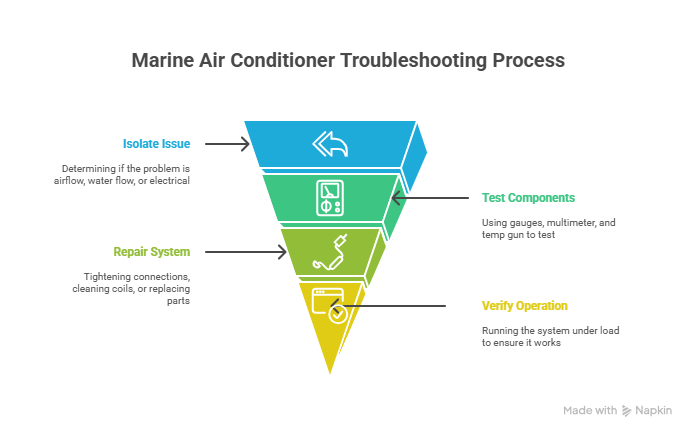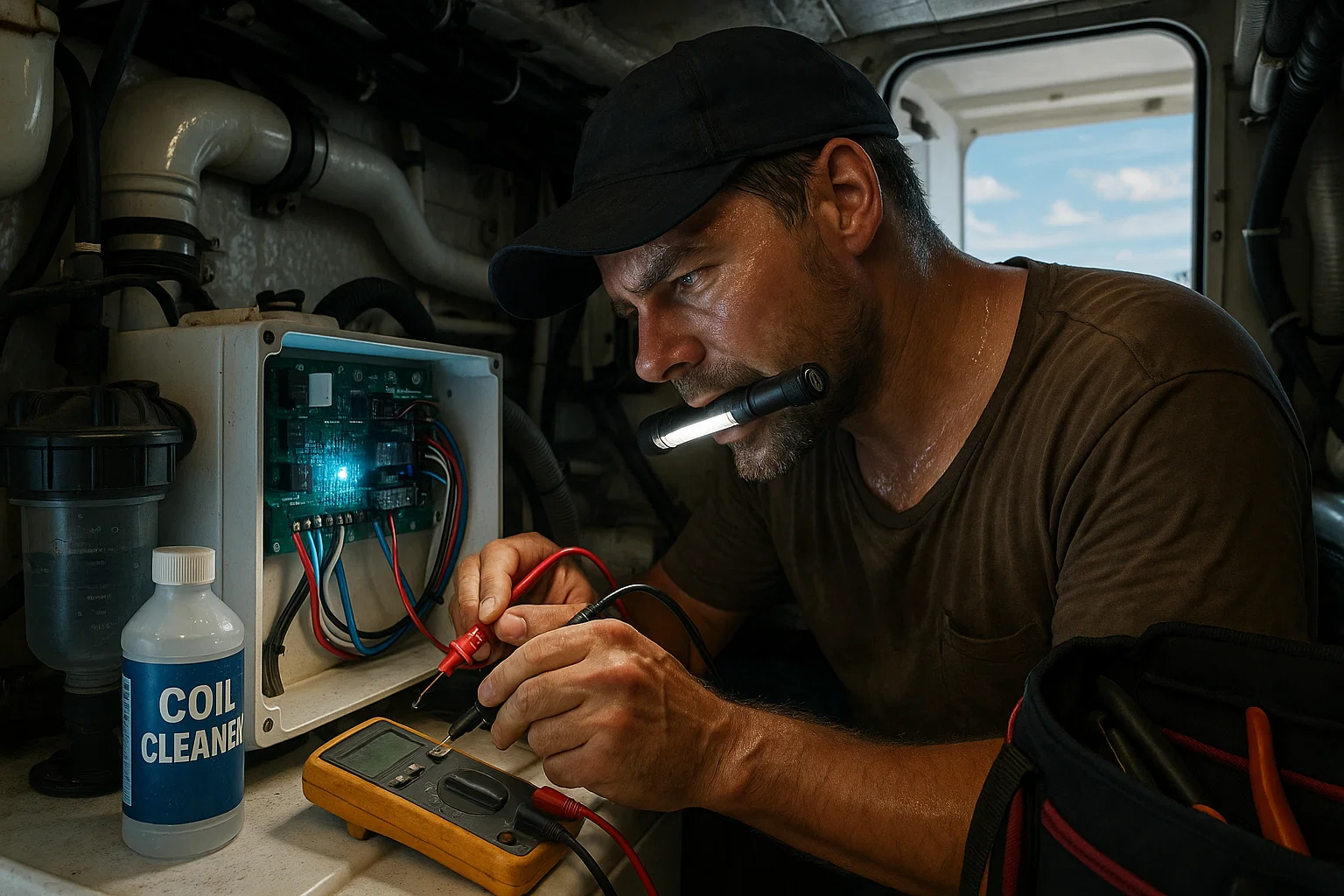Marine Air Conditioner Troubleshooting – A Dock-Side Playbook
I’ve been crawling around engine rooms in Miami and Fort Lauderdale for fifteen years, and nothing torpedoes a weekend faster than a dead chiller. This marine air conditioner troubleshooting playbook is exactly what I run through when a client radios from Bahia Mar, “Alex, the cabin’s an oven!” Follow along and you’ll cut the guesswork, the sweat, and the service bills.
Table of Contents
Why Listen to Me?
- 15 years fixing onboard HVAC from Key Biscayne to the Dry Tortugas
- 300-plus units rebuilt, from tiny 6 k BTU self-contained cubes to 72 k BTU split monsters on sport-fishers
- ABYC & EPA-608 certified—so yes, I can legally handle refrigerant
Hitting the Basics Before You Panic
Before diving deep into marine air conditioner troubleshooting, I grab three things: a flashlight, a multimeter, and a cup of Cuban coffee from Dinner Key’s dockside café. Nine times out of ten, the fix hides in plain sight.
- Breaker tripped? Flip it.
- Air filter caked? Rinse it.
- Sea strainer packed with sargassum? Clean it.
- Raw-water pump humming but no flow? Prime it.
Do those, and you’ll solve half the “emergencies” I get called for.

Understanding Your System
Self-Contained vs. Split
- Self-contained: everything in one noisy steel box under the berth—easy marine air conditioner troubleshooting when space is tight.
- Split: compressor in the engine room, evaporators in the cabins—quieter, cooler, trickier to service.
The Cooling Loop in 30 Seconds
Warm cabin air → evaporator → compressor → condenser cooled by seawater → expansion valve → back to evaporator. Miss any step and you’ll be Googling “marine air conditioner troubleshooting” while sweating buckets.
My Five-Step Diagnostic Flow
- Observe – noises, odors, error codes.
- Isolate – airflow, water flow, or electrical?
- Test – gauges, multimeter, temp gun.
- Repair – tight connections, clean coils, replace worn parts.
- Verify – run 15 minutes under load.
I log every reading in a spiral notebook; scribbles beat memory when three boats call at once.
Field Notes: Common Failures & Real Costs
I pulled these numbers from jobs I closed in Miami last season.
| Failure | Typical Cause | Dock-Side Fix | Average Cost | My Verdict |
|---|---|---|---|---|
| Unit won’t power | Breaker, corroded lugs | Clean, re-terminate, die-electric grease | $120 | Easy DIY |
| Low water flow | Strainer clogged, pump air-locked | Flush strainer, reprime pump | $180 | Keep spare impeller |
| Compressor trips on high pressure | Fouled condenser, low seawater | Acid-flush coil, check thru-hull | $350 | Preventable |
| No cooling, compressor runs | Refrigerant leak | Pressure test, evacuate, recharge | $750 | Call a certified tech |
| Short cycling | Bad sensor, low voltage | Replace temp probe, tighten grounds | $200 | Common on older Bertrams |
That table alone nails half of my marine air conditioner troubleshooting calls.
Electrical Glitches: Where Gremlins Hide
I’ve chased more 12-volt ghosts than I can count.
- Check voltage at the unit: under 11.5 V DC while cranking the compressor? Your batteries are the culprit.
- Wiggle every spade connector; if it’s green or crusty, cut and crimp new.
- Control pad throwing “HPF” or “LPF”? That’s high- or low-pressure fault. Cross-check with gauges before swapping boards.
Remember: power off before probing—240 VAC bites harder than a startled barracuda.
Water Flow Woes
Last August, Javier’s Sea Ray 340 off Stiltsville lost cooling. Raw-water outflow looked like a dribble instead of a firehose. A quick marine air conditioner troubleshooting check showed barnacles clogging the thru-hull. Fifteen minutes with a dive knife, full flow restored, cool beers all around.
Golden rule: you need at least 1 GPM per 12 k BTU. Less than that and head pressure skyrockets.
When to Throw in the Towel
- Oil slick on the bilge under the compressor? Likely a refrigerant leak—EPA says call a pro.
- Compressor drawing locked-rotor amps every start? Replacement time.
- Repair quote > 50% of a new unit? Upgrade. Modern units sip half the amps.
Knowing your limits is part of smart marine air conditioner troubleshooting.
Proactive Care: 20-Minute Monthly Routine
- Back-flush sea strainer.
- Vacuum or replace air filter.
- Pour white vinegar through condensate drain.
- Spray evaporator with coil cleaner, rinse gently.
- Visually scan wiring for green crud.
Stick to that, and I’ll see you at the sandbar instead of the service yard.
FAQ – Dock-Talk Quick Hits
Why does my unit shut off after 5 minutes?
High pressure from low water flow—clean the strainer first.
Can I run AC on the hook with an inverter?
Yes, if you’ve got a beefy lithium bank and soft-start compressor.
What’s the sweet spot seawater temp?
Under 90 °F. Over that, every marine air conditioner troubleshooting chart shows capacity dropping fast.
Do I really need descaling?
Once a year minimum. Acid flush dissolves calcium that kills condensers.
Key Takeaways
Keeping your cool on the water means a properly functioning marine AC. This guide empowers you to tackle common issues, saving you time and money. Here are the essential insights:
- Master your marine AC basics, identifying key components and system type to diagnose issues efficiently.
- Prioritize safety by disconnecting power, then follow a step-by-step diagnostic process starting with simple checks.
- Inspect all power sources and consult your owner’s manual for error codes during marine air conditioner troubleshooting.
- Implement routine care—monthly filters, sea strainer checks, coil cleaning—to prevent common problems.
- Recognize when to call a pro for complex issues like refrigerant leaks or major component failures.
- Gather key tools like a multimeter and verify wiring against diagrams.
- Evaluate repair viability—if costs exceed 50% of a new unit, consider upgrading.
Ready to become your own marine AC expert? Dive into the full guide above for detailed steps and preventative tips.
Author Bio
I’m Alex, a 15-year marine HVAC tech based in South Florida, ABYC and EPA-608 certified. I’ve overhauled 300+ chillers from Key Largo fishing charters to 70-foot motor-yachts at Bahia Mar, specializing in fast, no-nonsense marine air conditioner troubleshooting and long-term efficiency upgrades.


Leave a Reply